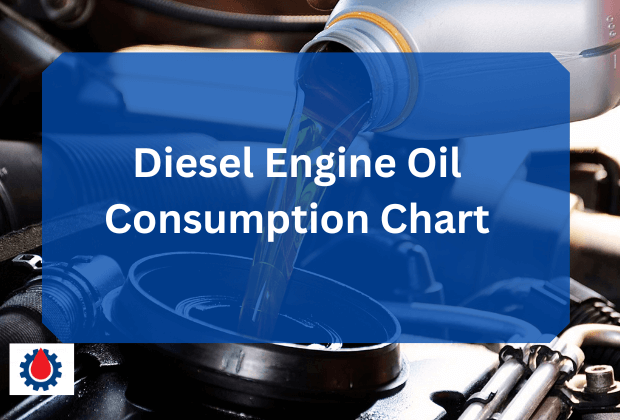Understanding your diesel engine’s oil consumption is more than just a maintenance routine, it’s crucial for performance, longevity, and cost efficiency.
Let’s explore what this chart entails, how to interpret it, and why it’s an indispensable tool in modern engine diagnostics.
Diesel Engine Oil Consumption Chart
| Engine Type | Oil Capacity (Quarts/Liters) | Normal Oil Consumption (Per 1,000 Miles / 1,600 km) | High Oil Consumption Indicator (Needs Inspection) |
|---|---|---|---|
| Light-Duty (<3L) | 4–6 quarts / 3.8–5.7 liters | ≤ 0.3 quarts / ≤ 0.3 liters | > 0.5 quarts / > 0.5 liters |
| Medium-Duty (3–6L) | 6–10 quarts / 5.7–9.5 liters | ≤ 0.5 quarts / ≤ 0.5 liters | > 1.0 quarts / > 1.0 liters |
| Heavy-Duty (6–10L) | 10–18 quarts / 9.5–17 liters | ≤ 1.0 quarts / ≤ 1.0 liters | > 1.5 quarts / > 1.5 liters |
| Industrial (10–15L) | 18–25 quarts / 17–23.7 liters | ≤ 1.5 quarts / ≤ 1.5 liters | > 2.5 quarts / > 2.5 liters |
| Commercial Fleet (>15L) | 25–40+ quarts / 23.7–38+ liters | ≤ 2.0 quarts / ≤ 2.0 liters | > 3.5 quarts / > 3.5 liters |
Related Diesel Engine Oil Grades Chart(Ultimate Guide)
What Is a Diesel Engine Oil Consumption Chart?
A diesel engine oil consumption chart is a graphical or tabular tool used to monitor how much oil a diesel engine consumes over time or mileage. It helps users identify patterns, detect abnormal usage, and schedule proactive maintenance.
This chart typically plots:
- Oil added (in liters or quarts)
- Mileage or hours of operation
- Intervals between oil top-ups
- Baseline oil capacity
Why Oil Consumption Tracking Matters in Diesel Engines
Diesel engines are robust but complex machines. Excessive oil consumption often signals:
- Worn piston rings or cylinder liners
- Valve stem seal deterioration
- Turbocharger issues
- Poor fuel quality or contamination
Monitoring consumption allows for:
- Early detection of mechanical issues
- Improved fuel efficiency
- Lower maintenance costs
- Compliance with manufacturer warranties
Related Diesel Engine Oil Temperature Chart(Comprehensive Guide)
Standard Oil Consumption Rates: What’s Normal?
According to many engine manufacturers, the acceptable oil consumption rate for modern diesel engines is:
| Engine Size | Acceptable Oil Consumption |
|---|---|
| <5L Engines | 0.25% of fuel consumption |
| 5–10L Engines | 0.5–1.0 liters per 1,000 km |
| >10L Engines | 1.0–2.0 liters per 1,000 km |
Note: These values vary depending on load, engine condition, oil quality, and driving conditions.
Related Engine Oil Consumption Chart(For All Engine Types)
How to Create and Use a Diesel Engine Oil Consumption Chart
1. Set a Baseline
Start by noting the engine’s total oil capacity and mileage at the time of a fresh oil change.
2. Track Oil Additions
Record every instance of oil added between oil changes. Include the date, amount, and mileage.
3. Calculate Consumption Rate
Use the formula:
Oil Consumption (L/1,000 km) = Total Oil Added ÷ (Current Mileage – Last Oil Change Mileage) × 1000
4. Graph the Results
Plot the oil consumption rate against mileage or time intervals. This helps visualize spikes or declines.
Related Deutz 4 Cylinder Diesel Engine Oil Capacity Chart
Diesel Engine Oil Consumption Chart Template Example
Here’s a sample layout:
| Date | Mileage | Oil Added (L) | Total Mileage Since Last Change | Oil Consumption (L/1,000 km) |
|---|---|---|---|---|
| 01-Mar-25 | 120,000 | 1.0 | 1,000 | 1.0 |
| 10-Mar-25 | 121,500 | 0.8 | 2,500 | 0.72 |
| 20-Mar-25 | 123,000 | 1.2 | 4,000 | 0.75 |
Digital Tools and Apps for Oil Consumption Tracking
Modern fleet management tools now offer digital logs and charts. Top-rated apps and systems include:
| Tool | Key Features |
|---|---|
| Fleetio | Real-time oil tracking, automated alerts |
| CMMS Systems | Maintenance scheduling, oil usage logs |
| Excel or Google Sheets | Custom templates, easy tracking |
These platforms allow integration with GPS and fuel systems, providing a more comprehensive performance overview.
Related Diesel Engine Oil Additives(Benefits & Top Oil Additives)
Common Causes of High Diesel Engine Oil Consumption
Understanding anomalies in your chart is key. Here are potential culprits:
1. Worn Piston Rings
Allow oil to enter the combustion chamber and burn off with fuel.
2. Faulty Turbocharger Seals
Leads to oil leaking into the intake system.
3. Valve Stem Seal Damage
Causes oil to leak past the valves and burn during combustion.
4. Poor Oil Quality
Low-grade or incompatible oil breaks down quickly, increasing consumption.
5. Overfilled Oil Reservoir
Creates excessive crankcase pressure, forcing oil past seals.
Related Normal Oil Pressure for Diesel Engines(Norma Pressure Range)
How to Reduce Diesel Engine Oil Consumption
Minimizing oil use is possible through regular care:
- Use OEM-recommended oil types and viscosity
- Ensure correct oil fill levels
- Replace air filters regularly
- Avoid extended idling periods
- Monitor blow-by levels
Diesel Engine Oil Consumption vs. Oil Leaks
Not all oil losses mean high consumption. Here’s how to distinguish:
| Symptom | Possible Cause |
|---|---|
| Oil stains under vehicle | External leak |
| Blue exhaust smoke | Burning oil |
| Frequent top-ups, no visible leak | Oil stains under the vehicle |
Related Engine Oil Leak – 7 Alarming Signs(How to Fix Them)
Manufacturer Recommendations and Service Intervals
Each manufacturer defines acceptable oil usage levels. For example:
- Cummins: Up to 1 quart per 1,000 miles is acceptable under certain conditions.
- Caterpillar: Offers detailed oil sampling and consumption limits by engine model.
- Detroit Diesel: Provides software tools to calculate expected consumption rates.
Following service manuals ensures warranty compliance and engine health.
Final word
The diesel engine oil consumption chart is more than a spreadsheet—it’s a diagnostic tool that empowers you to catch issues early, reduce costs, and extend engine life. Consistently tracking oil usage and understanding the trends.




